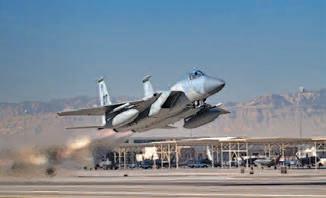
9 minute read
F-15CEagleWeaponsSchoolEndsatNellisAFB ByChristieVanover,57thWing
F-15C EAGLE WEAPONS SCHOOLENDSAT NELLIS AFB
By Christie Vanover,
Advertisement
57th Wing Public Affairs
The United States Air Force is continuing to modernize its future fighter force, and part of that evolution includes the sunset of the F-15C Eagle division of the United States Air Force Weapons School Weapons Instructor Course.
The single-seat F-15C Eagle entered the U.S. Air Force inventory in 1979, and weapons officers have been trained on the aircraft’s tactics at the Weapons School at Nellis Air Force Base in Nevada since 1978.
Those years of tradition came to an end Dec. 8, as the last cadre of students and instructors flew the final defensive counter air vulnerability for Weapons Instructor Course 21-B.
Maj. Rodolfo Cruz is the director of operations for the 433rd Weapons Squadron and one of the last five WIC instructors for the F-15C. He graduated as part of class 18-A, and became an instructor in 2019.
“I love the F-15C,” Cruz said. “We always brag about the record of 104-tozero and that is predominately based on the fact that we have the air superiority fighter. I don’t want it to die, but we have to move on, because if we continue to rest on our laurels, it’s going to make the fight that much harder for us.”
Cruz said he took a different approach when teaching this last iteration of students, because as the students transition, they will likely be in their jobs a bit longer since there will be no subsequent students to replace them.
“We spent a little bit more time on the critical thinking concept rather than finessing the individual Eagle execution that they should already know. We had to think about how we as the Weapons School think about problems, so that when the graduates go out into the Combat Air Force, they can think about the problems in the same manner,” he said.
Maj. Michael Tope, WIC 21-B F15C class leader, said he and his fellow F15C WPS graduates are prepared to take on the new leadership role as the airframe’s last Weapons School graduates.
“We are having to pivot as an Air Force,” he said. “We train against the current threats and to be ready in case we need to employ. The baseline threat has changed so much, and the ranges at which people are shooting and dying in air-to-air war have increased so significantly over the last 20 years, it is pretty incredible.
“The F-15 has some advances, but it’s still the F-15 from the 1970s in a lot of ways,” he added. “That speaks to the capabilities of the maintainers and the people who have worked on the jets, as well as the instructors who have developed different tactics.”
At the Air Force Association’s annual Air, Space & Cyber Conference in September, Gen. Mark Kelly, commander of Air Combat Command, discussed the Air Force’s future fighter roadmap.
“We must move the Air Force from seven different platforms toward four plus one,” Kelly said at the conference. “We must keep the F-22(Raptor) dominant for air superiority in a highly contested environment and facilitate a hot handover with our Next Generation Air Dominance capability.”
He said the F-35 Lightning II will be the cornerstone of the contested environment force, with the F-15E Strike Eagle and EX providing the big range, big weapons and disruptive fifth-generation avionics and sensors to complement the F-35. The newest F-16 Fighting Falcons will remain an affordable capacity fighter, and the A-10 Thunderbolt IIs will be the “plus one.”
At Nellis AFB, the Eagle Aircraft Maintenance Unit, 57th Wing Maintenance Group, maintains 16 F15Cs, which are assigned to the 53rd and 57th Wings. The jets will be relocated to several locations. Some will be reassigned to various Guard units or to Eglin AFB, Florida for test missions. Others will be sent to a depot for refurbishing or to a boneyard in Arizona.
Following WPS 21-B, Eagle AMU will deactivate, and maintainers will be assigned locally or will be relocated to meet the needs of the Air Force. Cruz and several other F-15C instructors plan to transition to the Air National Guard, while Tope is going to Eglin AFB to work with the F-15EX test and evaluation program. As the F-15C program ends at Nellis AFB, the F-15EX fighter program will continue to make advancements. Operational test missions were conducted at Nellis AFB
An F-15C Eagle takes off to conduct its final defensive counter air vul during Weapons School Integration 21-B at Nellis Air Force Base, Nev., Dec. 8, 2021. As the Air Force continues to modernize, this class marks the final F-15C Weapons Instructor Course to be taught at the United States Air Force Weapons School. (William R. Lewis/U.S. Air Force)
in October and additional testing is anticipated at the base in the future.
“It’s hard for us to forecast what the next fight is going to be like but we can anticipate that it’s not going to be like the fights we had in the past,” Cruz said. “When we talk about air superiority and air dominance, we don’t want to associate that with one airframe or two airframes. It’s going to be something more unconventional.”
Why Mojave
Continued from Page 13
and Kelly Hall (his co-writer of The Next Five Minutes and co-presenter that day) also went through some of the history of The Rutan Aircraft Factory and Scaled Composites with stories about his brother Burt and Mike Melville (both icons who were dearly missed at the event). The combination of hearing stories from the past and seeing the audience peppered with other aviation pioneers who have “returned home” is a uniquely impactful experience.
Looking around and seeing Scaled Composites engineers who have since put men in space with a plastic rocket, local test pilots flying unnamed-vehicles, former engineers for the Rutans now flying developmental electric multi-copters, and folks learning to fly their own homebuilt aircraft was to see an active heritage. Knowing the ways in which those people in the background that day are continuing to achieve in aerospace, the ongoing work not discussed at the event is a legaThe Mojave Air and Space Port from above. (Diane Barney) cy of Voyager, a legacy of Mojave, and is the extra layer that makes being in this community feel not just special but, in a way, timeless.
Living “in” Mojave made me eligible to run for a position on the board of directors for the Mojave Air and Space Port. The summer of 2020, I answered my phone and it was Dick asking if I would consider running for election. A few billboards and a mess of paperwork filed at the Kern County Courthouse later, I made it. And at the Voyager anniversary event I also made it into one of Dick’s thank-yous. Even though I was a footnote, it warms my heart to be seen as having helped keep Mojave on the path of being an airplanefriendly place and also collectively having voted to incorporate the Rutan’s name into the name of the airport (we’re leaving it ambiguous as to which brother it is but Dick says it’s for Burt).
After the presentations and the book signings, Dick walked up to me to say, “We did it.” I like to joke about how I wonder if it’s because he believed in me or if it’s because I’m one of only three people he knew who lived in the district and would therefore be eligible for election. Whichever was the case, I got to hear him say he was proud of me and that he gets choked up thinking about what a good direction the Mojave Air and Space Port is headed in.
It means the world to me to be a small positive force at this place and for these people that inspire me so. While Dick isn’t around as often to tell stories at the Voyager restaurant, you never know what you’re going to see out those windows facing the flightline. I can’t wait to see what happens next “in” Mojave.

20
In Flight USA Celebrating 38 Years
U.S. Air Force 75th Anniversary
Continued from Page 14 pendent service in 1947.
Maj. Gen. Billy Mitchell, also known as the “Father of the Air Force,” was one Airman who paved the way for the service. According to military historians, his commitment to pushing boundaries and working towards a distinct aerial service branch seeded a renaissance for the airpower legacy that would distinguish itself during conflicts across the globe for years to come.
Likewise, Gen. Henry H. “Hap” Arnold, who was designated the first and only five-star General of the Air Force by President Truman, also played a key role in leading, developing and innovating American military airpower during World War II, providing the necessary vision and drive to ultimately create the conditions for an independent U.S. Air Force following the war. Today, Gen. Arnold is considered an airpower pioneer whose efforts helped to lay the foundation for modern Air Force logistics, R&D, and operations, according to the National Museum of the U.S. Air Force. The Air Force’s history is also the history of the nation’s advancements in space. Under the Air Force’s early space pioneers such as Gen. Bernard Schriever, the Air Force developed and integrated the technologies that put U.S. rockets and satellites into space. By Operation Desert Storm in 1991, often called the nation’s first space war, space became central to nearly all military operations. These same technologies that brought victory in Desert Storm, such as GPS and communication satellites, are now essential to modern life in America. The importance of space grew to such an extent that the U.S. Space Force emerged as an independent service within the Department of the Air Force in 2019. “This is what is being celebrated as the U.S. Air Force and the Department of the Air Force enter their 75th years and what was on display in the skies over California when the B-2 roared overhead: 75 years of American airpower, spacepower, and innovation that have secured our nation and made us stronger,” said Brig. Gen. Patrick Ryder, Department of the Air Force Public Affairs director.

The U.S. Air Force Total Force Band plays in the Tournament of Roses Parade Jan. 1, 2022, in Pasadena, Calif. America’s Air Force participated in America’s New Year Celebration to kickoff 2022 and the yearlong celebration of the 75th anniversary of the Department of the Air Force. (U.S. Air Force/ Nicholas Pilch) Air Force Chief of Staff Gen. CQ Brown, Jr., his wife, Sharene, and Chief Master Sgt. Daniel Valadie, U.S. Air Force Total Force Band drum major, take a promotional photo together before the Tournament of Roses Parade and Rose Bowl Dec. 31, 2021, in Pasadena, Calif. America’s Air Force participated in America’s New Year Celebration to kickoff 2022 and the yearlong celebration of the 75th anniversary of the Department of the Air Force. (U.S. Air Force photo by Nicholas Pilch) (U.S. Air Force/ Nicholas Pilch)


Aviation & Airboat Wood or Composite Propellers Sensenich Wood Propeller Co. 2008 Wood Court, Plant City, FL 33563 Phone: (813) 752-3711 • Fax: (813) 752-2818 Email: propsales@sensenich.com Aviation Fixed Pitch Metal Propellers Sensenich Propeller Manufacturing Co., Inc. 14 Citation Lane, Lititz, PA 17543 Phone: (717) 569-0435 • Fax: (717) 560-3725 Email: sales@sensenich.com

SENSENICH Awarded STC for Carbon Fiber Adjustable Prop for Super Cub






